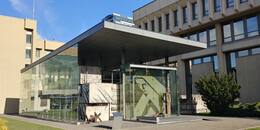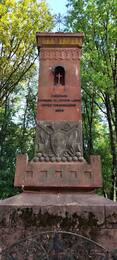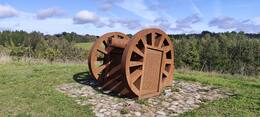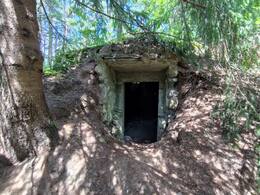Along the Baltic Way from Vilnius to Riga
Day 1.
180 km
Vilnius - Moletai - Panevėžys
Practical info
- The itinerary is intended as a guide - how to optimally travel a region or country, or two countries, with the aim of getting to know their military heritage;
- The driver must plan for himself - how many of the recommended objects and places he can explore in one day;
- Before traveling, you should check the opening hours of sightseeing places (museums, collections, fortifications, etc.);
- For places where advance booking is required (local guides, private collections, etc.), a visit must be booked, specifying the date and time. If the trip is cancelled, the places booked must be informed;
- Accommodation must be booked in advance. Accommodation may be unavailable during the summer season, especially on the coast. Some catering establishments may not be open during the winter season;
- Choose not only summer for your trip, but also other seasons;
- The Latvian-Lithuanian-Estonian borders can be crossed by road freely without restrictions and at any time of the day. When entering from one country to another, you must have an ID card or passport with you;
- Visit tourist information centers where you can get additional information, brochures, and maps.
Sights
January 13th Memorial of the Seimas of the Republic of Lithuania
The monument is located in Vilnius, in front of the Second Palace of the Parliament (Seimas) of the Republic of Lithuania. In January 1991, the people of Lithuania surrounded the Par liament Palace with barricades, in a fight for and in defence of their freedom. It was an attempt to protect Lithuania from military aggression by the Soviet Union of the time – Soviet at tempts to stage a coup d’état in Lithuania and restore Soviet rule. Barricades surrounded the Parliament building until the end of 1992. In 1993, in front of the Palace of the Seimas of the Republic of Lithuania, a unique memorial was erected – made of parts of the barricades and other relics – it was dedicated to the Lithuanian people who sacrificed their lives for freedom. On 13 January 1991, tragic events unfolded, as the Soviet Army and special forces occupied the Lithuanian Radio and Televi sion Centre building and the television tower, killing 14 freedom fighters and injuring around 600 people. As the tenth anniversary of the Defenders of Freedom Day was approaching, a decision was made to preserve the composition by creating a memorial to 13 January. The Memorial was inaugurated in 2008. The memorial preserves an authentic fragment of the 1991 par liamentary barricades and has a chapel with an icon to the Blessed Virgin Mary. The memorial displays objects brought by people and provides an insight into the events that took place during the defence of the independence of Lithuania.
Monument to the Soldiers Killed for Lithuania‘s Freedom in 1920
The monument is located in Giedraičiai.
On 19 June 1932, a monument dedicated to the fallen Lithuanian freedom fighters was unveiled in Giedraičiai. The construction of the monument was initiated by the inhabitants of Giedraičiai – the painter and author of the monument Antanas Jaroševičius, Pastor Meigis, Malvina Valeikienė and Matas Valeika, who sup ported the Lithuanian soldiers in battle, the community of Širvintos and the Lithuanian Army; the amount of 11,000 litas was raised for the construction of the monument. The appeal for donations for the monument states that it is being built “to honour victory and our eternal joy, which will remind us of the historical significance of the site and pay tribute to the soldiers buried in Giedraičiai”. The opening ceremony was sumptuous. It was attended by the President of the Republic of Lithuania, A. Smetona – Command er-in-Chief of the Lithuanian Armed Forces, representatives of the 2nd, 4th, 7th, and 9th Regiments and officers, who took part in the Battles of Giedraičiai. Flowers were dropped at the monument from military planes, and Malvina Valeikienė, a prominent Lithu anian personality and one of the organisers of the construction works of the monument, read out the names of the Lithuanian soldiers who died in Giedraičiai, and she was awarded the Order of the Cross of the Knight, 3rd Class. The flag of the local rifle men unit was consecrated at the monument. From 1962–1964, pursuant to the instructions of the Soviet administration, an un successful attempt was made to demolish the monument, but it was later declared a historical monument.
A stylised cannon commemorating the 100th anniversary of the Battle of Giedraičiai
A stylised cannon commemorating the 100th anniversary of the Battle of Giedraičiai is located behind the town of Giedraičiai, 200 m after turning off on road No. 172.
On 21 November 2020, a monument by sculptor Džiugas Jurkūnas was unveiled on a hill at the site of the Battle of Giedraičiai, commemorating the victory. The monument is a stylised interpretation of the battles of the Lithuanian Army against the Polish Army during the inter-war period. In an attempt to move away from the description of the conflict, the monument highlights the importance of the union of the two countries in the context of contemporary events. The rust-covered cannon symbolises the strong union of the re publics of Lithuania and Poland – two countries that fought each other a century before. The situation of the time is described on the sides of the monument; the Lithuanian and Polish Army units involved are mentioned and a brief description of the battle is provided. The Lithuanian Armed Forces are the initiator and the funder of the erection of the monument
Eastern Lithuania (King Mindaugas) region Lithuanian partisan command post
After driving past Andrioniškis Cemetery (there is a signpost), there is a preserved hideout – a command post. From 1944– 1949, a command post of the Lithuanian partisans of the Eastern Lithuania (King Mindaugas) region operated in this hiding place. In the summer of 1944, Balys Žukauskas, with brothers Petras and Juozas Jovaišos, established the hiding place to evade the mobilisation announced by the Red Army in 1944. At the end of 1945, Antanas Slučka-Šarūnas started to use the hiding place. He was the first one to form a partisan unit in the Troškūnai area and later united the partisans of Rokiškis, Anykščiai, Kavarskas, Troškūnai, and Andrioniškis to form the Šarūnas Unit. In 1947, A. SlučkaŠarūnas became the commander of the Algimantas district, and in 1949 – the commander of the Eastern Lithuania partisan region. This means that from 1949, the hiding place became the command post of the Lithuanian partisans in the Eastern Lithuania region. The hiding place, which had successfully sheltered partisans for five years, was betrayed on 28 October 1949. The farm where the partisans were hiding was besieged by KGB troops; the partisans refused to surrender and blew themselves up.
The bunker has been preserved, and a cross and a monument to the fallen have been installed.
Monument dedicated to Algimantas Military District partisans
The monument is located in the centre of Troškūnai, Anykščiai district, near the Church of Holy Trinity. During the partisan war of 1944–1953, the territory of Lithuania was divided into nine partisan military regions. From 1947–1950, partisan units of the Algimantas region of Lithuania, the establishment of which is closely related to Troškūnai, were active in the Panevėžys and Anykščiai area. The inhabitants of this town organised partisan units in Aukštaitija. The first partisan commander of the Algimantas region, Antanas Slučka-Šarūnas, was born and lived in Troškūnai.
In 1996, pursuant to the initiative of the Genocide and Resistance Research Centre of Lithuania, a monument dedicated to the partisans of the Algimantas Military District was erected in Troškūnai. The monument was created by sculptor Jonas Jagėla and architect Audronė Kiaušinienė. The main part of the monument is a black stone gate that symbolises the fallen defenders of the homeland. The bronze crosses on the sides of the gate symbolise the Christian faith, while the bronze sword, like the sword of St Michael the Archangel, symbolises the light of faith and hope. In the square in front of the monument, a black stone plaque commemorates the three units of the Algimantas region: Šarūnas, Žalioji and Kunigaikštis Márgiris.
Places to eat
- In Vilnius, see govilnews.lt.
- Restaurant "Atradimai", Moleta
- In disease, see. truelithuania.com
Places to stay
- In Vilnius, see govilnius.lt.
- Hotel Vila Kelmyne, Moletai
- In Panevėžys, see truelithuania.com








